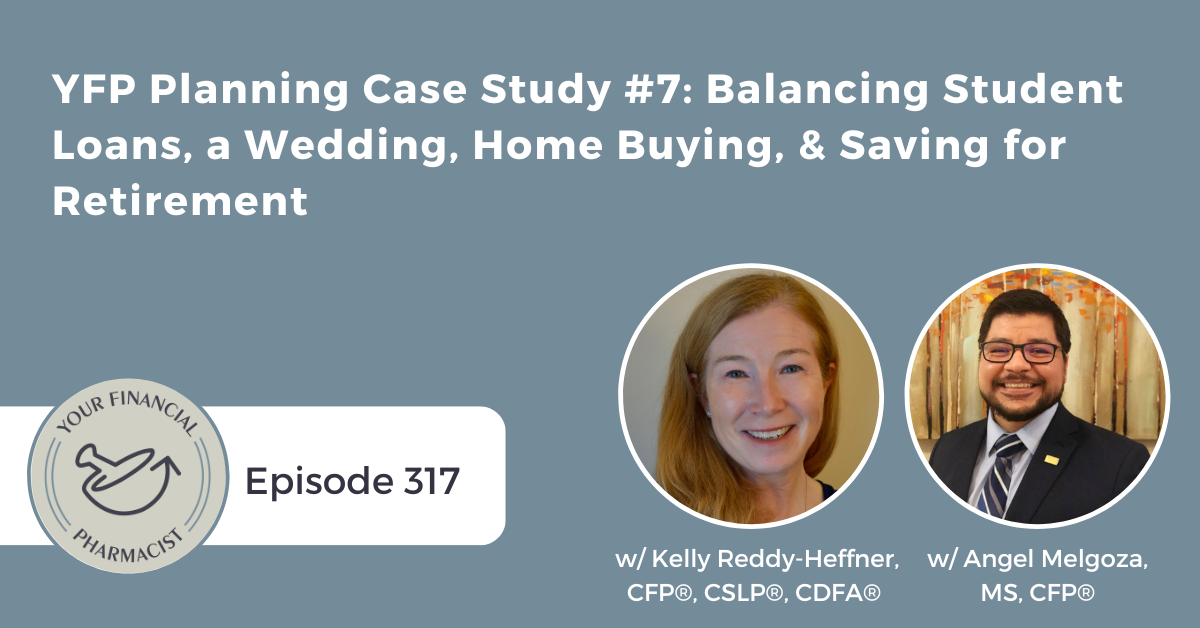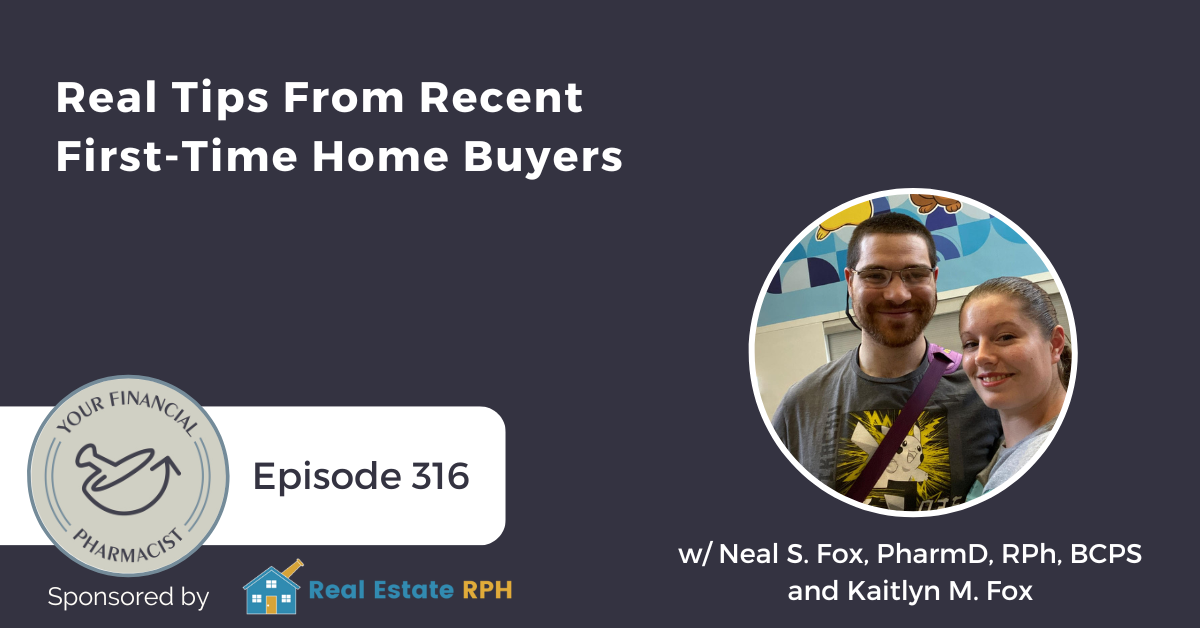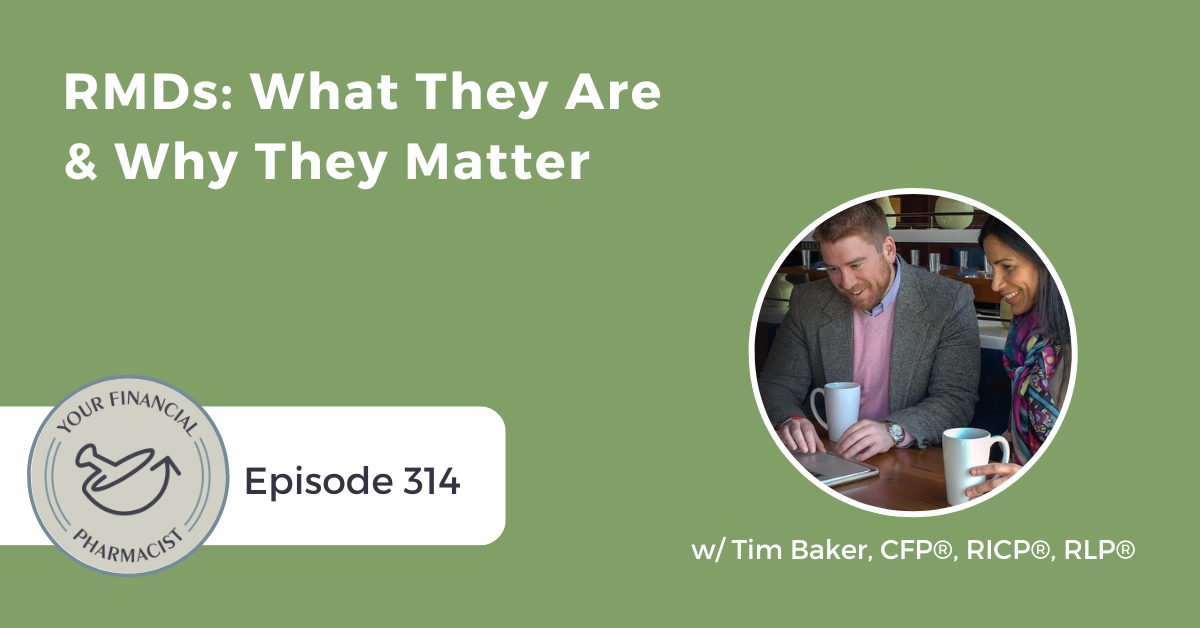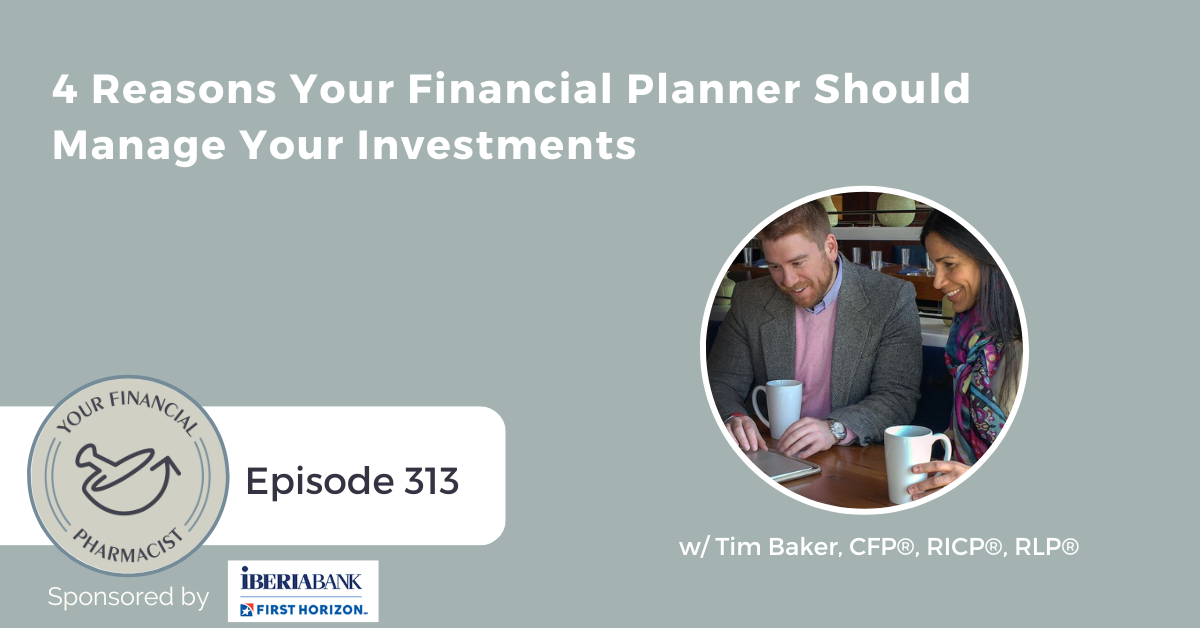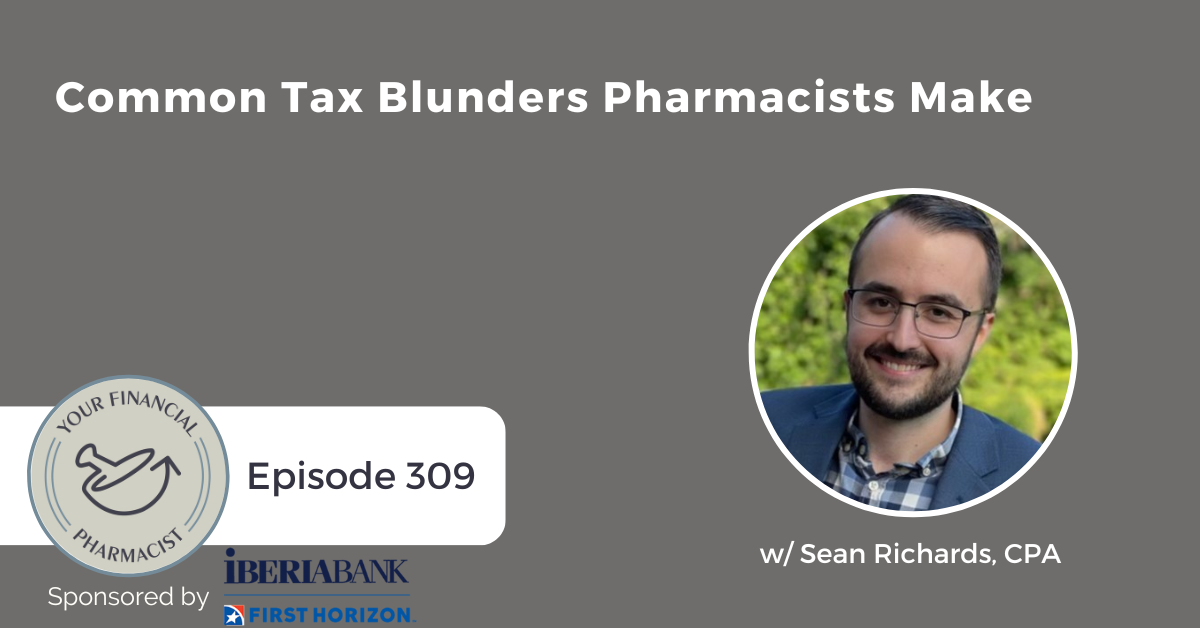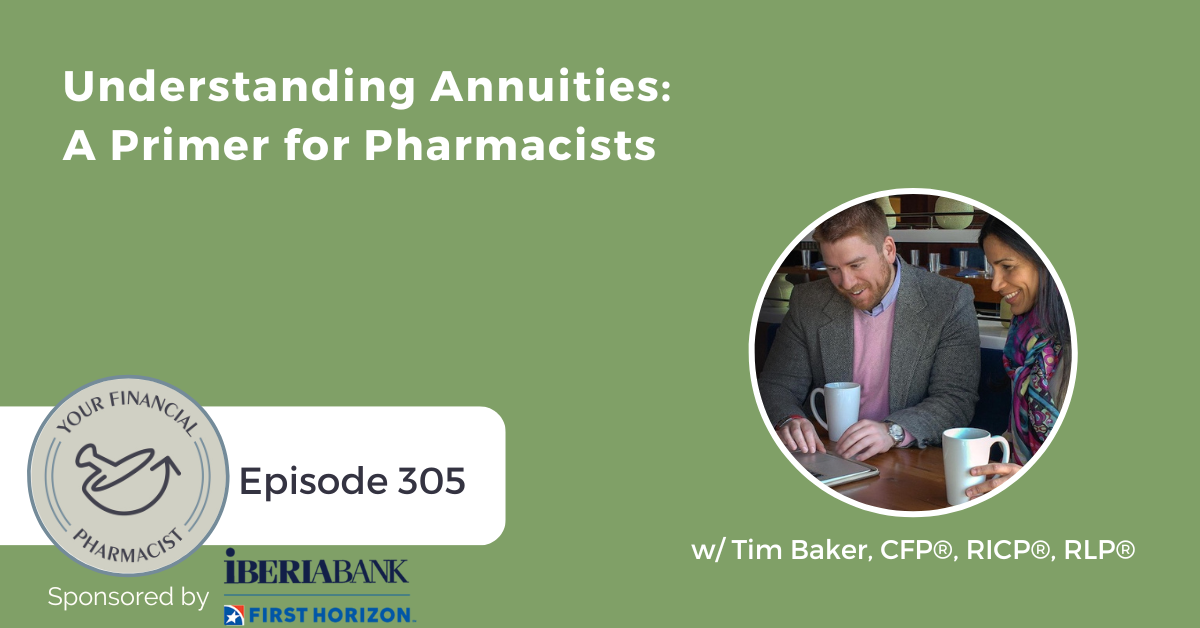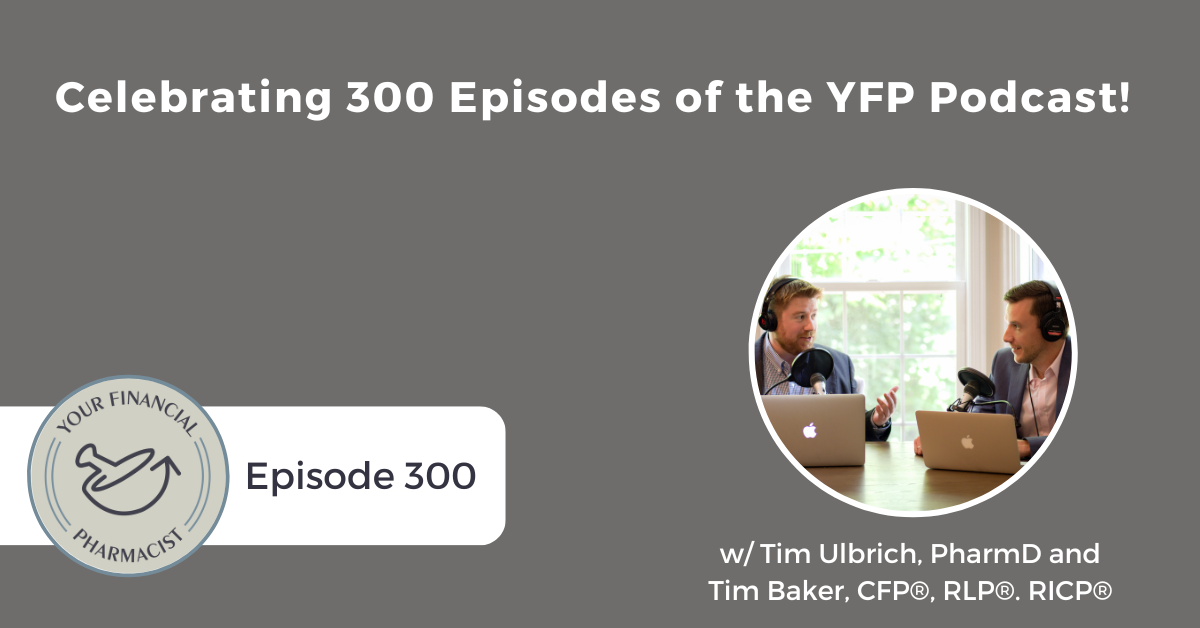The team at YFP Planning discusses a case study that includes balancing student loans, a wedding, home buying, and saving for retirement.
Episode Summary
Welcome to our seventh installment of the case study series with Tim Baker, CFP®, RLP®, Kelly Reddy-Heffner, CFP®, CSLP®, CDFA®, and Angel Melgoza, MS CFP®. During this episode, we are sharing a fictitious case study with you about an engaged couple in their 20s. We delve into their finances, expenses, and their goals before discussing their assets, savings, investments, liabilities, and debt. Angel and Kelly discuss why they would tackle student loans before anything else in this couple’s financial plan, how recent changes announced to student loans will impact their loan repayment strategy, how marriage, children, and other big life events affect financial planning, and the importance of emergency funds and savings. Finally, we talk about why wealth protection is so important and why we see clients struggle with that the most.
Key Points From the Episode
- A warm welcome to today’s guests, Kelly Reddy-Heffner and Angel Melgoza.
- Some details of the fictitious case study we will be discussing today.
- The first thing they would tackle with regards to this fictitious case study.
- How Biden’s bid to forgive some loans will affect the power of PSLF.
- How financial planners work with clients on massive life events such as marriage and children.
- The importance of having an established emergency fund and focusing on savings.
- Why clients struggle most with wealth protection and why it’s imperative.
Episode Highlights
“Figuring out a strategy is key to the plan.” — Angel Melgoza [0:11:48]
“Our clients need cash flow because – the goal is to pay off – the loans – sooner rather than later.” — Angel Melgoza [0:11:58]
“Clients do need to be candid about their goals and one of our objectives is to help clients do what they want to do within those realistic [goals].” — Kelly Reddy-Heffner [0:24:09]
“Layers of life typically influence how much [wealth] protection is needed and how comfortable you feel with what you have.” — Kelly Reddy-Heffner [0:30:36]
Links Mentioned in Today’s Episode
- YFP Planning: Fee-Only Financial Planning for Pharmacists
- Kelly Reddy-Heffner on LinkedIn
- Angel Melgoza on LinkedIn
- Tim Baker on LinkedIn
- YFP Planning: Fee-Only Financial Planning for Pharmacists
- YFP Disclaimer
- Subscribe to the YFP Newsletter
Episode Transcript
[INTRODUCTION]
[0:00:00.4] NH: What is up everyone? Welcome to our seventh installment of our case study series. I am joined by Angel Melgoza and Kelly Reddy-Heffner. Guys welcome back. We have a great case study to talk about today. How is everything going? Angel, Kelly, what’s going on in your worlds?
[INTERVIEW]
[0:00:18.2] AM: Trying to keep up with the heat, trying to stay cool here in Texas. We’ve hit triple digits though, making sure my AC is still working.
[0:00:25.9] NH: How about you, Kelly?
[0:00:27.5] KRH: Yes. I know, what’s up with all the weather and weird things? I am avoiding the outdoors due to smoke infestation and hoping some Canadian wildfires get put out soon.
[0:00:39.7] NH: Yeah, our very own Paul Boyle sent out some pictures of where he’s at in Ohio and some of the smoke that’s coming down from the Canadian fire. So definitely has some air quality issues here in Ohio and Angel, I am with you. I am not in Texas, our case study today is actually in Texas.
But our AC is on the fritz and right now, we are kind of battling with our home warranty people to try to figure that out. So hopefully, we get that figured out before the hot temperatures get here to Ohio but good to have you guys on, and looking forward to run in through the case study here.
So what we’re going to do is we’re going to kind of go through the case study and then obviously, if you’re listening on the podcast, we’re going to talk through this as best we can. If you’re watching this on YouTube, you’ll be able to kind of see the case study as we walk through it. So we’re really going through it.
This is a fictitious couple, they are an engaged couple living in Texas and Angel will kick us off, and then Kelly, we’ll kind of go through some of the goals. I’ll go through the balance sheet, and then we’ll just kind of look at this case study, what are some of the things that pop out to us, and how we would approach this from a planning perspective.
So, Angel, let me share my screen. So the people that are watching can see this. Let me see right here, share. So without further ado, Angel, why don’t you take us away as this pops up here?
[0:02:00.4] AM: Let me kick it up, these are my fellow Texans, right? Even though they’re a little fictitious. So we have Meghan Myers, who is aged 29, is a clinical pharmacist. Mathew Higgins, age 27, he’s an IT tech. You know, pretty typical age of current clients that we have, right?
Salaries for Megan, she’s earning USD 150,000 annually. Mathew’s earning USD 100,000 annually with supplemental income, USD 10,000. I’m guessing that may be some add-on work that they’re just taking on. Currently, of course, single. Filing single but they are engaged to be married.
See, they’re residents of Austin Texas, five hours north of me. Tell me you’re Texan by not telling me you’re Texan. You mentioned this in five hours and not by having on debate. So on a combined gross income front, they’re both earning, combined 260,000.
A little bit about their expenses, we try to divvy up fixed variable and poor savings as well. From expenses standpoint, the fixed expenses or about 32.50 monthly, USD 2,000 on variable, and about 1, 242 in just savings commitments that they have.
[0:03:11.3] NH: Awesome. Kelly, why don’t you go take us through Meghan and Mathew’s goals?
[0:03:15.6] KRH Sure, so I have reached out to do some financial planning because they’ve got a couple of things on the horizon. There are some student loans, which is not uncommon for our client base and we know there’s been a lot of chatter all summer about student loans and finally, some of the next steps are starting to unfold. So that’s often a prompt to reach out and start a conversation.
So they want to have a plan in place for Meghan, she does work for a qualifying 501(c)(3). So PSLF and a forgiveness strategy is part of the conversation. They are planning to get married so honeymoon, wedding expenses, we know one of the inflation items that’s still up is travel. So they’re planning a very fun honeymoon, it is good to plan ahead for that and as far and advance as possible.
They are looking to make sure that retirement’s on track and feel like they’re a little bit behind. Also, again, not an uncommon feeling. So that’s one thing we will want to dive into and see what that looks like, try to come up with a student loan plan that also matches a strategy for some of those other goals like wedding, marriage, and retirement and then of course, big things with life in general, often include that first home purchase.
We know that’s been an interesting environment as well, so we’ll kind of talk through what the home purchase environment looks like, what the resources are available to expand, and be knowledgeable about that big, that big purchase. Children, not too far down the road as well, and then of course, vehicles, open to the conversation about owning versus leasing but do identify having a new car need in the next couple of years as well.
[0:05:09.2] NH: Yeah, good stuff Kelly. Thanks for taking us through that. So I’m going to go through kind of the balance sheet, the net worth statement. So I’m going to start on the asset side. So they have about USD 5,000 in checking and joint checking. USD 20,000 in joint savings. When we look at their investment accounts, they both have 401(k)s. Meghan has about 10,000 in her current 401(k). Mathew about 15,000 they’re both in target date funds.
About 90% in equity, so probably goes 20, 60 target date funds that are out there. Currently, they’re both putting in 5% but Mathew actually gets a match up to 6%. Meghan’s is 5% so that’s a plan and opportunity right there. Meghan has a little bit of money in her HSA, USD 2,000. I mean, she’s contributing the max to that and Matthew does have access to an HSA because he’s got a high-deductible health plan but he’s not getting enrolled.
I believe Mathew has a Robin Hood account that has about USD 5,000 and he’s putting about USD 200 a month into that and then Meghan is not sure what to do with her old 401(k), which has about 5,000. So total assets of about 62,000. On the liability side, so these are the things that we owe, it’s a little bit of short-term debt there, about USD 5,000 on a credit card for Meghan, USD 3,000 on a credit card for Mathew.
They try to pay that off monthly, Mathew does have a car note that is USD 250,000 per month at an interest rate of 4%. So we’ve seen those obviously go up recently, so not terrible, right? In this environment and then the big, you know, monstrosity there I think are the loans. So she has about USD 425,000 in loans between her private and her federal loans. So total liabilities of 453,000.
So that puts their combined net worth at negative 391,000. So just to reiterate, they’re doing their own taxes now. So definitely, something that we would look at as we’re looking at the student loans, and then we do have a section here for like wealth protection. Meghan does have group life insurance coverage so two times her salary at USD 300,000. Mathew has one and a half times so $150,000.
They both have, you know, kind of a standard work term and long-term disability policies through their employers so own-Oc for two years and any-Oc after that and then professional liability, Meghan does have her own policy, which is good to see, and then no estate plan at this time, so definitely something to look at. So to kind of reiterate, Meghan hates the loans and wants to see them gone but is open to hear about PSLS.
So that would definitely be something that we would want to walk through and show her the math. Mathew again doesn’t have any loans, student loans. They are looking into stopping and funding the taxable account and put those dollars towards debt, and then as Angel mentioned, Mathew does have some contractor work that he makes on the side. So as we look at this, Kelly, what would you say is the first thing that you would tackle with this particular client as you review the case study here?
[0:08:08.7] KRH: Well, I’m going to assume that probably, the prompt was the student loans to get that plan in place. So there are a couple of little low-hanging fruit items but they all do work together like pieces of a puzzle to fit. So I guess that would be where I would start to just have an idea of what that monthly payment would be so that we can build the rest of the plan around that.
[0:08:35.9] NH: Yeah. I mean, I think, for a lot of our clients, you know, the tail that wags the dog for their financial planning is the student loans. So as the loans go, so does the rest of the plan. So if we’re talking about this amount of debt, I think again, it’s not necessarily a push to pay them off. But more of a push to have a plan to pay them off.
So I think you know, one of the things and I’ll skip over to this tab here and that kind of outlines the student loans, I think really with this particular client, you have lots of moving pieces here. You’re probably going to have a strategy that is related to the federal loans and then a strategy that is related to the private loans.
I think the thing that I often say is that the range of outcomes here with regard to the loans can be vast and if you’re looking at our tab here, the total amount paid, and this is kind of the rough numbers given the present student loan plans that are out there, is anywhere from 143,000 to 480,000.
So we really want to make sure that as we are approaching the loans, the idea is that we’re going through our process. So what we typically do and what we do for this client is that we’re going to inventory the loans and we typically do this through the NSLDS ugly text file that we have you retrieve.
With potentially, with private loans, look at the credit report. Sometimes, we look at promissory notes as well, and then from the inventory, now that we know where we’re at, we’re going to look at all of the different possibilities related to said loans, right? So we want to put the emotion that Meghan has with her loans with the math that supports it.
I’ve joked about this, Kelly and Angel, in the past, that I remember talking to a client that basically is working 20 hours at a for-profit job and 20 hours at a nonprofit job and didn’t qualify for PSLF because you essentially need to be 30 hours and they were like – and they had substantial debt. I don’t think it was up to this and now but they were asking like, “What was my advice for the student loans?” and I was like, “If I can push a broom in a nonprofit for 10 hours a week, I would do that” because it just unlocks a lot of the benefit that PSLF affords.
So the third part of this really is once we figure out what that strategy is, we want to optimize that, and that’s where you know, looking at the tax situation, looking at the investment strategy and the pre-tax situation, making sure you’re filing the taxes correctly, so I would obviously want them to talk to Shawn Richards, who is our director of tax and make sure that the tax situation is jiving, not just with the financial plan but specifically the student loans.
So that’s my take. Angel, would you add anything kind of in the student loan picture as you’re looking at this? Obviously, it’s a huge decision in terms of what they’re going to do and will hugely affect the balance sheet as they kind of start, you know, their careers and their lives together.
[0:11:44.9] AM: Absolutely, just like you said, just like Kelly said, that figuring out a strategy is key to the plan. What I would do also is really engage in budget. You know, we have to understand that our clients needs cash flow because if the goal is to pay off you know, the loans, more sooner rather than later but the cash flow just isn’t there, then we have to say, “Okay, what adjustments do we need to make as planners to our recommendation?” PSLFP in the strategy but the repayment plan may be a little bit different than what they may expect.
[0:12:19.5] NH: Yeah, and to that point, the B word, the budget word never goes away. I mean, even if you are looking at you know, a retirement picture, we kind of know, have to know like what we need to build out as a retirement paycheck. That all stems from the budget, right? So I think that is going to be consistent.
I think to the sheet, I don’t know if we outlined it, I think there was a budget for like two to three thousand or three to four thousand for Meghan to apply towards the loans, and the strategy might be a compromise in strategy where we are aggressive with the private loans, try to get them into an aggressive payoff strategy because obviously, we know that those loans are not going to be eligible for PSLF.
But then we are doing what we can to maximize forgiveness on the federal loans and that’s kind of where the two-prong approach to the loans really stems from. Kelly, if we stay with the student loans, obviously, we’re still waiting for and waiting and waiting and waiting for the Supreme Court to kind of rule on Biden’s effort to forgive some loans and we think that based on that decision, the president or the government will try to put a plan out there that might be more favorable to borrowers.
Can you kind of elaborate a bit on what you’ve heard or what you’ve read about that and kind of how that could potentially affect PSLF and the power of PSLF in the future as we come out of the pause here?
[0:13:43.1] KRH: Sure. So, great, Tim, you were referring to that you know, one time, 10 to USD 20,000 discharge decisions. So you know for some clients, that’s a substantial part of their loans but for many pharmacists who have accumulated student loan debt, it’s not quite as big of a percentage.
So the kind of flip side to that that you referenced is, we’re still waiting to hear about new income-based repayment plan like new repay that would have a different formula to calculate the monthly payment. The goal with the PSLF program want us to complete it and be in it for the 10 years, 120 estimated payments but also to pay the least amount over time, which is why you see that 143,000.
I can understand Meghan’s concern about a 10-year period to have the loans in existence but referencing Angel as well with the budget, you know if you have USD 3,000 and you’re putting 20 – like 1,400 to 2,300 towards the private loans. One, there’s only going to be so much left out of that budget but two, why would you pay extra if you qualify and are doing the work in the nonprofit?
But you need to get the loans in the correct position. So if that new repayment plan comes out and is very advantageous, the formula, making that payment lower, will create a lower amount total paid over time, which is a win. It does feel like we’re continuing across a couple of presidential administrations to make PSLF as easy as possible. So sometimes, clients still have concerns, “Will the program still be in place, will I qualify?”
All the answers point towards yes based on what we know, you know across a couple of different administrations, there have been you know, programs put in place to make it easier but you do have to put the loans in the right position. So we’ve seen these wavers as well and there’s still one more waver until the end of the year to pick up as many payments as possible. Pretty much the key being that you did work for the nonprofit during the timeframe.
But if you had odd forbearances, if you were in the wrong repayment plan, if you were in the wrong loan type but that’s some of the work that we do as part of the planning processes. Making sure that every loan is in the correct position to qualify and to not have that outcome when you get a surprise. There’s no surprises, you’re keeping track of your cumulative account. You know, there’s – that’s what the issue was in the past.
[0:16:44.2] NH: Yeah, and shout out to Tim Ulbrick who recently held a kind of impromptu webinar about student loans and you know, what’s beyond the pause, I think we had about 600 people register for that webinar and there were a lot of questions about PSLF and there’s still a lot of misnomers out there about the program and is it viable, is it not viable.
To your point Kelly, there has been things that in the past, would lead borrowers to question the longevity. I would say that everything that I could have read about that has always been for future borrowers. I mean, if you’re in the program, I think they would grandfather it in. This is my belief and I think if you’re reporting a strategy of forgiveness, you know there’s a good case, especially if they put out this new payment plan that your balance is going to grow.
So to kind of take that away, you know, retroactively I think would be catastrophic, and even with tax law, they typically will write things and that’s why we have so many versions and layers of tax law. I will point out as we’re showing the slide if it is a pay as you earn, the numbers that we’re showing on the screen is, “Hey, in ten years, you’re going to pay off 143,000.”
There is two assumptions here that are, I think are wrong, one is if let’s say Meghan’s been at work for the last two years or maybe it’s the last year, she’s already a year in. So we’re projecting 10 years as if this were starting right now, so she potentially already has 12 to 24 months that are counted or potentially counted if we do the right things and then I think the other thing is that we’re showing a first monthly payment of a USD 1,080, which could also be a lot less given a new repayment plan.
So this again, so many advisors out there still to this day as I talk to a lot of prospects will say, “Hey, I’m working with an adviser and they say don’t worry about the loans, it will figure themselves out” which is the worst advice that you can give to many pharmacists that are dealing with six figures worth of debt or they’ll do a, “Hey, pay the highest interest rate off or pay the lowest balance.”
That quite frankly is subpar advice, so because the spectrum of outcomes is so why with regard to what you actually are paying out of your pocket for the loans, you want to make sure that you get a professional advice on this because it’s that impactful. So guys, let’s set the loans aside for a hot second and talk about the other parts of their plan.
Angel, obviously with wedding, honeymoon, first home, kiddo in the next two years, car in the next five years, how does a planner work with a client to kind of wade through all of these things that obviously are huge life events but obviously, from a planning perspective, hugely important to kind of road map? Walk me through how you would approach Meghan and Mathew in that instance.
[0:19:40.0] AM: Sure. I mean, I think firstly as we address the student loans, the second thing looking at their budget, what’s left over after we define a good repayment plan for them, and as a planner, we want to make sure that we are being very upfront, real, and having real conversations as to expectations, right? The last thing we’d want is to take out more debt when we don’t need to.
[0:20:04.7] NH: That’s right.
[0:20:06.2] AM: Just going through what their expenditures are, what’s left over, and coming up with a comfortable budget for all these things, you really can’t plan them for an additional family member but at least, you know jeffing up what does that look like on a nationwide kind of average scale. Typically, when I am working with younger individuals I like to throw in an extra two, three grand a month for raising a child.
You know, that is very subjective but that is very much kind of my flat conservative rule of thumb.
[0:20:37.5] NH: Yeah. I mean, I am a big believer in if I’m breaking this down with a client, and Kelly I’d love to hear your thoughts on this too, I’m a big believer in saying, “Okay, you know wedding, honeymoon, how much is that? Is that paid for? What other sources of income or what is the sources of savings for that?” “First home, okay, is it within the next year, the next two years? So what are we looking at for a down payment?”
Obviously, I want to put them in front of someone like Nate Hedrick, to help with an agent and finding an agent or even Tony Umholtz to look at First Horizon and potentially a PharmD loan and make sure that that is positioned and then you know, yeah, first child in the next two years, what does that look like from a daycare expense or just hospital bills, who’s and where are we funding that and then car.
You know, if that is a five-year, so kind of backwards plan into this and you know we talk about purpose-based investing. You know, kind of by proxy, I’m a big fan of purpose-based savings, so I would love to see a bucket for a house, I would love to see a bucket for a car, I would love to see a bucket for kiddos. Like I was joking around with someone, we have an ally account that is the kid’s account and the sub-accounts are Olivia, my daughter, Liam, my son, and Benji, our dog.
So, Benji, you know for his grooming and vet bills and things like that, Olivia for swim and other things like that. So it allows Shay and I to kind of break these expenses down when we throw all of these things against the wall, Kelly, it’s overwhelming, right? It’s just a lot of things one right after the other. So walk me through kind of like how you would approach that, how you would select buckets, how you would determine like, “Okay, overlaying the student loans” and maybe that’s where the student loans were like, “Well, maybe we need a little bit of extra discretionary income and go out.”
Not five years in the private loan but maybe 10 years to free up some income for us to do some things, so walk me through that in terms of the savings perspective.
[0:22:35.0] KRH: Right, because once we have like one set of numbers with the student loan, you want to build out, as you said Tim, those buckets but you need to run some estimates. So typically, you know I probably would start with the house but clients do need to be candid about their goals and one of our objectives is to help clients do what they want to do within those realistic like giving pros and cons and, “Well, that might take a little bit longer if you want to do it at that amount.”
So certainly it would be up to them, what the priorities are in terms of wedding, house, preparing for a child, and that new car but giving some context to those decisions. So like if the new house is in a year, you’d be looking at some estimates if you bought a USD 250,000 home versus a 450,000. Right now in the current environment, it’s super fun to do the two interest rates like this crazy but you know, are people still able to buy homes?
Yes, but you need to know what that’s going to look like in terms of a mortgage payment but then, I also like to run the numbers at like a 4% so in case the environment changes in the next year, it makes a big difference in the monthly payment. Are you doing a 3% down, a PharmD loan, or are you doing 20% down, something in between? So kind of run a couple of those numbers you can see a range.
You know, if this is what you want to do on the lower end or on the upper end, this is the amount per month in a year timeframe to do it and to get to the down payment. Definitely, childcare, one of the biggest parts of a child expense. So making sure that we have a good holding place in the budget for that. Looping back to the house, you know, it seems obvious but doing that amount for a year and knowing you can do it for a mortgage amount makes a lot of sense.
Like if your rent’s a thousand, you want to buy a house and the mortgage is 2,500, typically that USD 1,500 difference, can you consistently put that away for a year, one for the down payment but two, that’s becoming your new average monthly expense. So like if you can do it for a year that feels pretty good that you’re going to be able to sustain it and continue it. So yeah, putting some context, some hard numbers knowing they’re not going to be to the penny.
But this gets you or I say, we can calculate to the penny but there is going to be lots of things that happen in between, you know, anything. A job change, a new dog, all the things you know that help influence that monthly budget, you know, we need to have a placeholder for.
[0:25:33.5] NH: That’s right and I think one of the things that we haven’t really discussed that I think is important to discuss, you know typically when we talk about a budget, we’re always looking at where can we potentially cut expenses and things like that. The thing I would really dig in with Mathew, in particular, is, “Hey, you have supplemental income of USD 10,000, is there a way for us to grow the topline income that’s coming in?”
So can we push that 10,000 to USD 25,000 next year? Meghan, you know, if we do have pretty hairy audacious goals, are there ways for you to also make additional dollars by picking up extra shifts or whatever? So I think sometimes we always look at the expense side of the ledger and I want to grow the pie and make sure that’s looking healthy and we have other levers that we can potentially pull.
Angel, let’s shift to the wealth-building stuff real quick. They’re kind of just starting out, they had this one old 401(k), they’re in some target date funds in their current 401(k), we don’t have many IRAs established, which I don’t know if I would necessarily do that now. Mathew has a taxable account of USD 5,000, which again, I would try to apply like when we’re asking questions about, “Hey, how are we going to fund the home payment, home down payment, or the car?” That’s where I want to start drawing those lines but how would you approach the wealth-building portion of their financial plan with kind of the facts that we have?
[0:26:50.5] AM: With some of the facts that we have, wealth building, and what I’d like to look at first is, “Do you have an established emergency fund?” because we all know that things do happen and stuff. I want to make sure that our clients are prepared for that. More on the, “Are you on track with savings?” things of that nature. I would definitely start off by looking at the 401(k)s, making sure that they’re at least maxing out the amount that they would receive an employer match.
From looking here, I believe that Mathew’s more deferring 5% but the match is 6%, maybe trying to get him up to that 6% is the next step for him. On the HSA fronts, it looks like they don’t put any money into an HSA. I think that is a very good tool for young healthy couples, right? That you traditionally just have your physicals, your checkups, and maybe a couple of doctor visits because of a cold or flu, what have you, and making sure that those are maxed out.
You end up saving on the payroll tax front, you end up saving on the federal income tax front, and to the point of going back to the student loans, Meghan can also reduce her adjusted gross income and that will even save her on the back end to know but yeah, to your point on the taxable account, seeing what’s that account for, right? You have a lot of goals that you want to achieve and maybe putting some purpose behind it.
We have it here listed as a play account but to me on a scale, if we have a pyramid of what’s important, play accounts would be at the tip. That’s the cherry on top for me, right? I would definitely want to address the menial things like again, your emergency fund. Are you putting into your 401(k)s and are your current savings do they have a purpose?
[0:28:33.5] NH: Yeah, that’s right and I think to circle back, I think Meghan is contributing the max HSA even though it is not showing, it is just showing in text there and she has about USD 2,000. I’m assuming it’s in cash and not invested. I think the discussion I would have about that is, “Are we planning on using this for the birth of a child or do we see this as like a long kind of that stealth IRA?” and maybe it’s, “We’re going to use it for the birth of a child then afterwards, build a backup and then it will be a self-IRA” or something to that effect.
You know sometimes, it is good to be able to cash flow health expenses when you get to that point. So for the current 401(k)s, I think you know looking to make sure that those target date funds, Kelly, look good. You know, often times we like to get out of the target date funds because they are a little bit more expense and basically pick the allocation ourselves, and then probably the last thing that we haven’t really talked to is just what do we do with the 401(k), the old 401(k)?
Do we roll that over to a rollover IRA for YFP to manage on behalf of Meghan or do we move that over to a current 401(k) to be able to assess that? Let’s chat Kelly, really quickly about the wealth protection stuff. My initial gut on this is probably, they’re probably okay at this point in time and I would want them to focus on the debt and wealth building but probably phase two, phase three might be looking more closely at the wealth protection stuff.
What’s your thought on that? Do you kind of differ in your opinion or would you say, “Hey, let’s kind of get through some of these other things that are on fire and then kind of pivot to life disability, estate plan” et cetera?
[0:30:10.0] KRH: Right. I mean, certainly the wealth protection piece, you know as much as some of the other things feel overwhelming and the volume is to tackle this actually is probably the area where our clients struggle the most just to see like how much to prioritize and what they really want to have and to figure that out. So right, I would agree, you know layers of life typically influence how much protection is needed and how comfortable you feel with what you have.
I do like that Meghan has enough coverage to cover her private student loans. That’s an area that’s a bit grey depending on the loan’s officer. So she’s got that covered, so really we try to look at liability need like if there’s something that needs paid off, that would be a big one. From there, we do, do that as part of our planning to do a very thorough assessment, see what they have, but I would agree.
You know, the estate planning we can do some conversation and work on that during the protection meeting like checking your beneficiaries, making sure the titling is correct on accounts. That’s one layer ahead of getting a will and formal documents in place. So yeah, I would say that something that we work on, you know, as we move through the financial plan, it is important but the amounts of coverage do look fairly reasonable.
I probably would address at some point the own occupation for two years on those disability policies. Our gold standard is typically to recommend own policies for clients in that area but again, they do have coverage. That would be just a note that I would just check into further.
[0:32:08.8] NH: Yeah, I think in this regard, what I’m doing as I am going through the wealth protection part of the financial planning is I’m looking at what the baseline coverage is and I’m planting seeds. I’m saying, “Hey, it probably makes sense in the future to look at your own life insurance policy. It probably makes sense in the future to look at your own disability policy. It probably makes sense in the future to have an estate plan that’s drawn up by an attorney.”
You know, I think these are typically most important and I say this a lot when you have a spouse, a house, and mouths to feed and we know that Meghan and Mathew are kind of treading in that direction. I think anybody needs an estate plan if they’re a human and they want to kind of, you know, their care and be able to pay their bills if they’re unable to but I think the ante is upped when you have other people that are kind of relying on you for their livelihood and we want to make sure that we take care of the family.
So in my mind, I’m kind of planting those seeds that say, “Hey, this is important now, it’s going to be more important in the future. So let’s take steps when we kind of get the dust cleared and settled on the student loans and the investments and things like that, a budget can make moves here in the future.” So great stuff guys, I really appreciate the conversation. I feel like we could go on and on about this particular client.
So thank you for kind of going through this with me in the seventh edition of the case study series. If you are out there listening to this and you’re thinking, “Hey, this sound vaguely familiar to my situation” don’t be shy, reach out to us, book a discovery meeting, and you know, let us know if we would potentially be a good fit to work together. So Angel and Kelly, thank you once again and looking forward to doing this next time.
[0:33:47.9] AM: Thank you for having us.
[END OF INTERVIEW]
[DISCLAIMER]
[0:33:51.8] TU: As we conclude this week’s podcast, an important reminder that the content on this show is provided to you for informational purposes only and it is not intended to provide and should not be relied on for investment or any other advice. Information on the podcast and corresponding materials should not be construed as a solicitation or offer to buy or sell any investment or related financial products. We urge listeners to consult with a financial advisor with respect to any investment.
Furthermore, the information contained in our archived newsletters, blog post, and podcast is not updated and may not be accurate at the time you listen to it on the podcast. Opinions and analyses expressed herein are solely those of Your Financial Pharmacist unless otherwise noted and constitute judgments as of the dates published. Such information may contain forward-looking statements, which are not intended to be guarantees of future events. Actual results could differ materially from those anticipated in the forward-looking statements. For more information, please visit yourfinancialpharmacist.com/disclaimer. Thank you again for your support of the Your Financial Pharmacist Podcast. Have a great rest of your week.
[END]
Current Student Loan Refinance Offers
Note: Referral fees from affiliate links in this table are sent to the non-profit YFP Gives. | Bonus | Starting Rates | About | YFP Gives accepts advertising compensation from companies that appear on this site, which impacts the location and order in which brands (and/or their products) are presented, and also impacts the score that is assigned to it. Company lists on this page DO NOT imply endorsement. We do not feature all providers on the market. |
$800* Loans* ≥150K = $800 100-149K = $450 <100K = $350 | Variable: 5.28%+ APR (with autopay)* Fixed: 5.28%+ APR (with autopay)* *All bonus payments are by gift card. See terms | The "Kayak" of student loan refinancing, Credible displays personalized prequalified rates from multiple lenders | ||
$750* Loans ≥150K = $750* ≥50K-150k = $300 | Fixed: 5.49%+ APR (with autopay) | A marketplace that compares multiple lenders that are credit unions and local banks | ||
$500* Loans ≥50K = $500 | Variable: 4.99%+ (with autopay)* Fixed: 4.96%+ (with autopay)** Read rates and terms at SplashFinancial.com | Splash is a marketplace with loans available from an exclusive network of credit unions and banks as well as U-Fi, Laurenl Road, and PenFed |
Recent Posts
[pt_view id=”f651872qnv”]

